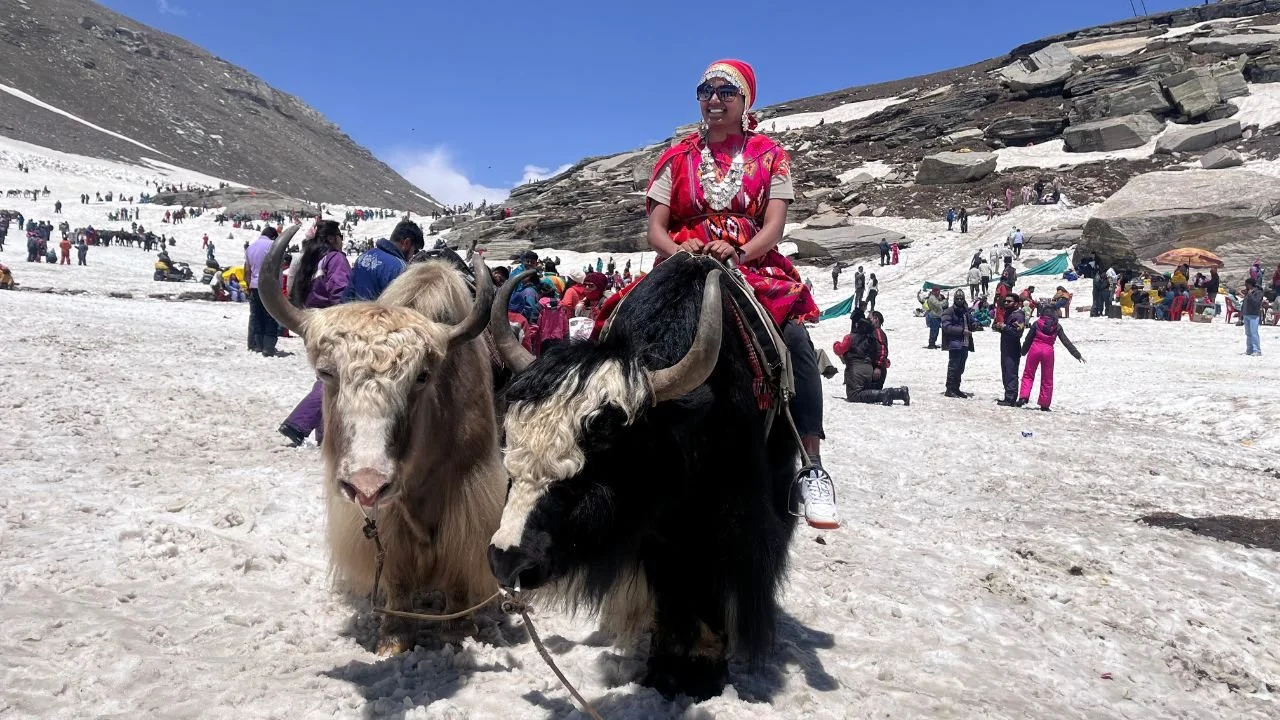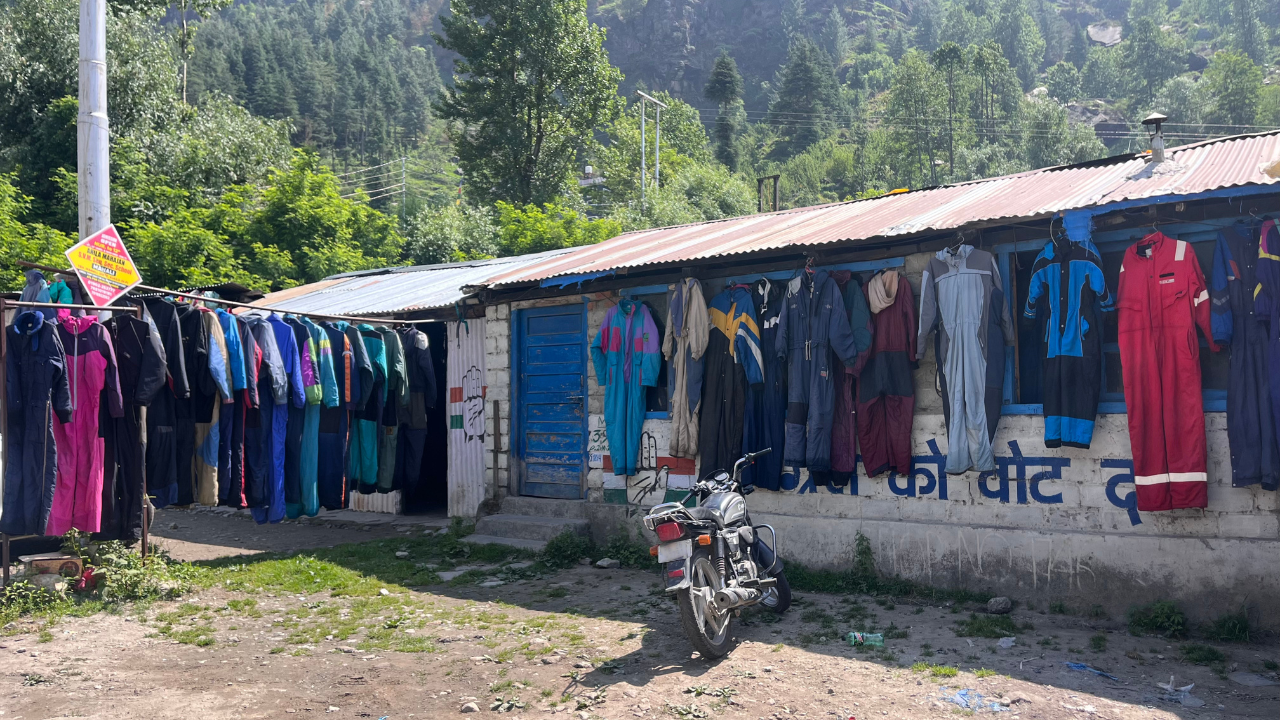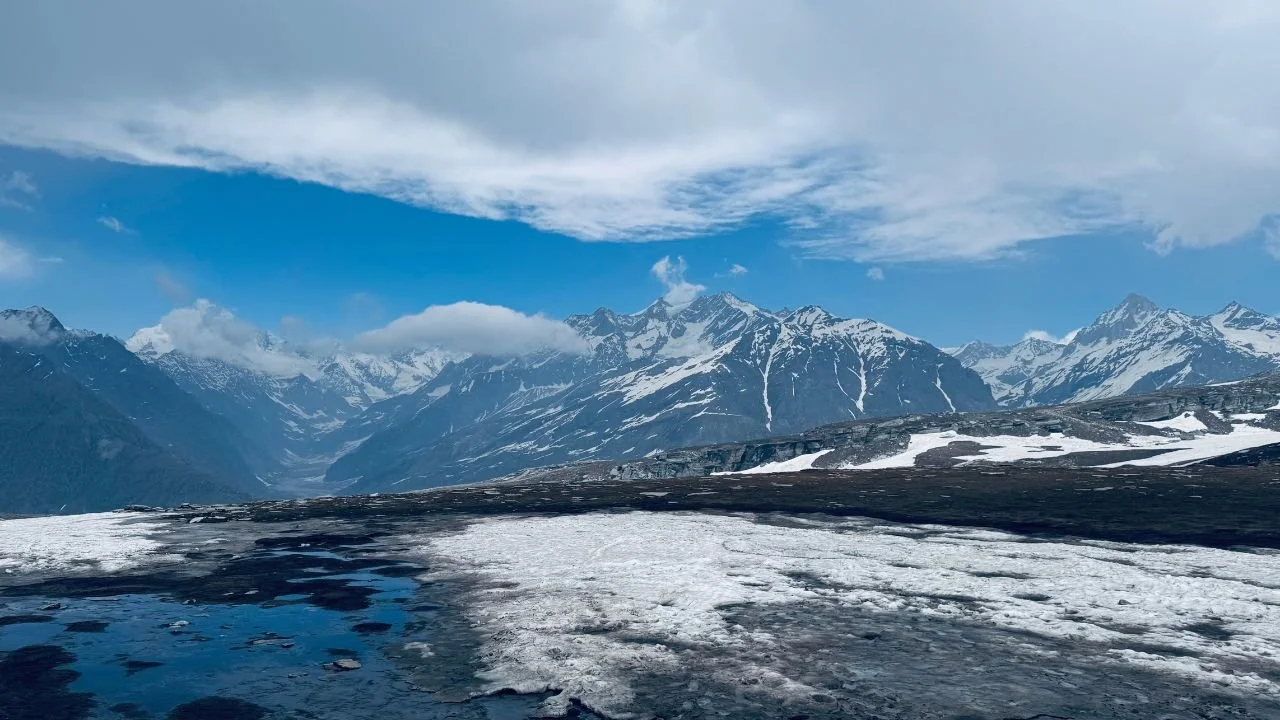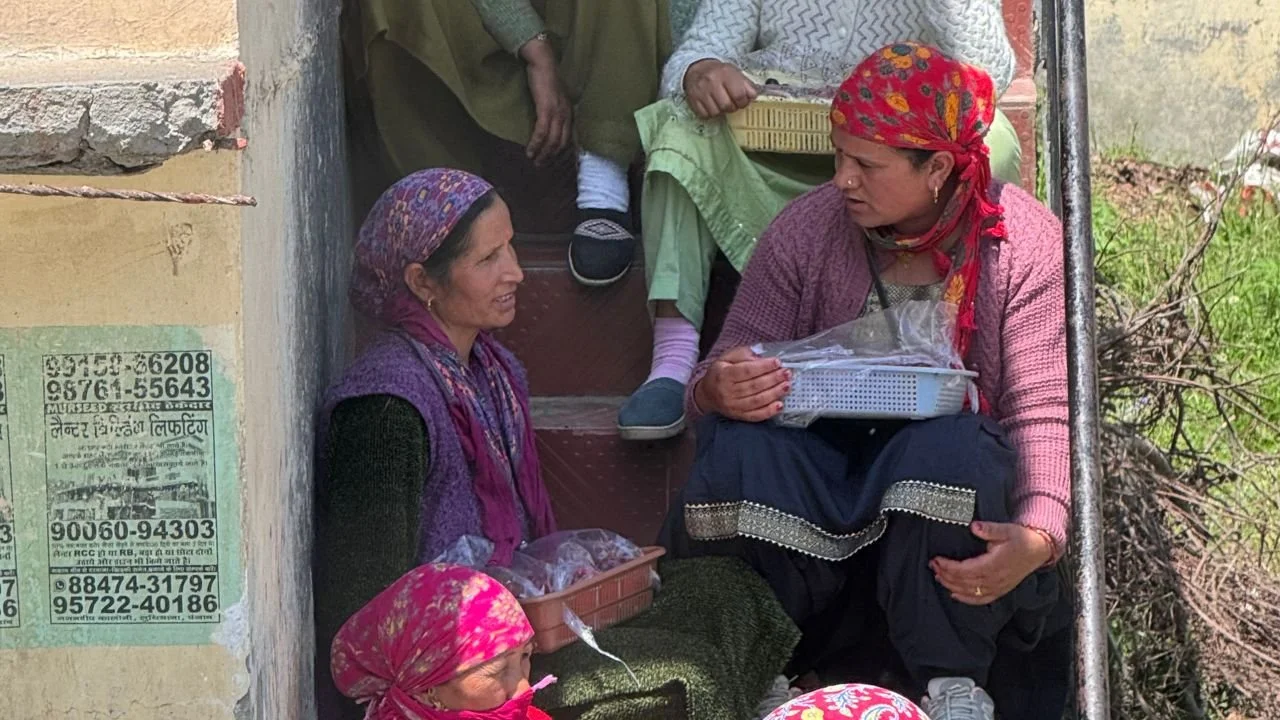At the Rohtang Pass, “We need tourists, but we also need clean air. It’s a tough balance.”
Photo: Quamar Equbal
Photo Story: Rohtang is a vibrant artery of travel, adventure, and survival, pulsing with stories of resilient people who call this rugged pass their lifeline. But unchecked tourism, pollution, and rising environmental concerns have left it under siege.
- Quamar Equbal and Sumit Singh
Nestled high in the Pir Panjal Range of the Himalayas, Rohtang Pass stands at 3,978 meters above sea level, a breathtaking gateway connecting the lush Kullu Valley to the stark, arid landscapes of Lahaul and Spiti in Himachal Pradesh. Its name, derived from the Persian words Ruh (soul) and Tang (narrow), translates to “pile of corpses,” a haunting reminder of the perilous journeys that once claimed lives due to treacherous weather and terrain.
Yet, today, Rohtang is a vibrant artery of tourism, adventure, and survival, pulsing with the stories of resilient people who depend on it and call this rugged pass their lifeline.
Rohtang Pass is a paradox, a place of serene beauty and unrelenting challenges. The 51-kilometer journey from Manali to Rohtang is a visual symphony: the Beas River gurgles alongside winding roads, lush meadows give way to rocky cliffs, and snow-capped peaks loom like silent sentinels. In summer, alpine wildflowers paint the slopes in hues of yellow and purple, while winter cloaks the pass in a pristine white blanket, drawing lakhs of visitors every year to witness its snowy spectacle. For many, Rohtang’s Zero Point, a high-altitude spot where snow lingers even in summer, is the ultimate destination, a place to revel in snowball fights, sledge rides, and the thrill of standing amid the Himalayas’ raw grandeur.
Photo: Quamar Equbal
But beneath this allure lies a fragile ecosystem and a community grappling with the dual forces of tourism and environmental strain. The pass—open from May to October and closed from November to April due to heavy snowfall—is both a blessing and a burden for those who rely on it. Its six-month accessibility fuels Himachal’s tourism economy, contributing significantly to the state’s revenue, but it also brings pollution, traffic chaos, and livelihood uncertainties for locals.
Rohtang Pass is a paradox, a place of serene beauty and unrelenting challenges… But beneath this allure lies a fragile ecosystem and a community grappling with the dual forces of tourism and environmental strain.
At Zero Point, the air is thin, and the wind bites. Here, pony-wallahs like Tenzin Dorje, a wiry man in his late thirties, guide tourists up steep, snowy slopes. His family has herded ponies across Rohtang for generations, offering rides to visitors too wary to trek the slippery paths. “The ponies are our life,” he says, brushing snow off his weathered jacket. “In summer, we earn enough to survive the winter when the pass closes. But the tourists leave trash, and the snow melts faster now. It worries me.”
Nearby, yak-wallahs like Sonam Angmo manage their sturdy beasts, which carry heavier loads or offer photo ops for tourists. Yaks, with their thick fur and calm demeanor, are suited to the high-altitude terrain, but their grazing lands are shrinking, as tourist footfall compacts the soil.
Photo: Sumit Singh
Sonam, a mother of two, earns ₹1000-1500 per day during peak season, but the closure of the pass for six months leaves her family dependent on meager savings. “We love showing our yaks to visitors,” she says with a smile. “But when the snow comes, we’re cut off. No work, no income.”
At Marhi, a midway stop en route to Rohtang, small dhabas line the road, their tin roofs glinting under the sun. Lakshmi Devi, a 45-year-old shopkeeper, stirs a steaming pot of Maggi noodles, the unofficial comfort food of the Himalayas. Her dhaba, a modest shack with plastic chairs, serves tea, parathas, and instant noodles to shivering tourists. “This pass is my bread and butter,” Lakshmi says, her hands chapped from the cold. “But the traffic jams and garbage piles make it hard. Tourists throw plastic everywhere, and we clean it up to keep the pass beautiful.”
These shopkeepers, many of them women, are the unsung heroes of Rohtang. They rise at dawn to prepare food, often sourced from local markets in Manali, and brave freezing temperatures to serve travelers. This is how they support their families, but the lean winter months force many to take loans or migrate to lower altitudes for work.
Photo: Sumit Singh
The road to Rohtang is a test of skill and nerve, with hairpin bends, icy patches, and frequent landslides. Cab drivers like Rajesh Thakur, a 32-year-old father of two, are essential for tourists. Charging ₹5,000 for a round trip from Manali, Rajesh navigates the Manali-Leh Highway with practiced ease, dodging oncoming trucks and tourist buses. “The road is dangerous, especially in rain,” he says. “But I know every curve. My cab is my lone earning source.”
The Atal Tunnel, inaugurated in 2020, has eased some pressure by offering a year-round route to Lahaul and Spiti, bypassing the pass itself. However, for tourists seeking the Rohtang experience, the tunnel is no substitute. The pass’s scenic route, with stops at Solang Valley and Rahala Waterfalls, remains a draw, keeping cab drivers like Rajesh in demand. Yet, the National Green Tribunal [NGT] limits daily vehicle permits to 1,200 (800 petrol, 400 diesel) to curb pollution, creating fierce competition among drivers. “We need tourists, but we also need clean air,” Rajesh admits. “It’s a tough balance.”
At Gulaba and Marhi, rows of shops offer snowsuits, gumboots, and gloves for rent at ₹500 per set. These rentals, often mandatory for cabs to proceed, are a vital income source for local women like Anita Sharma. A group of women, many from nearby villages, run these stalls, providing warmth to underprepared tourists. “We started this business because men were driving or guiding,” Anita explains. “It’s hard work, washing and drying suits in the cold, but it gives us independence.”
Photo: Quamar Equbal
These women, often widowed or supporting large families, employ dozens in their small enterprises, from stitching suits to managing inventory. Their work not only sustains households but also empowers them in a traditionally male-dominated region. However, the seasonal nature of the pass means their income vanishes for half the year, pushing many to seek alternative livelihoods in Manali’s markets.
Rohtang’s beauty is under siege. The influx of vehicles such as cars, buses, and snow-driving vehicles like snow scooters has led to air and noise pollution, with exhaust fumes staining the once-pristine snow a dirty brown. Environmentalists warn that rising temperatures are accelerating glacier melt in the region, threatening water sources like the Beas and Chandra rivers. Non-biodegradable waste including plastic bottles to food wrappers is littered across the pass, despite many local efforts to clean up.
In 2016, the NGT’s cap on vehicles sparked protests from locals dependent on tourism, highlighting the tension between conservation and livelihoods. “We want to protect Rohtang, but we need to live too,” a member of the Manali Hoteliers’ Association said on the condition of anonymity. He argues that dispersing tourists to nearby sites like Hamta Pass or Bhrigu Lake could ease pressure on Rohtang, but infrastructure lags. The Himachal Pradesh Tourism Development Corporation [HPTDC] has introduced eco-friendly Himtarang electric buses, and plans for a ropeway from Kothi to Rohtang are underway, but these measures are yet to fully address the environmental strain.
Photo: Sumit Singh
For the communities of Kullu, Lahaul, and Spiti, Rohtang is more than a tourist spot. It’s a lifeline. The pass’s closure from November to April isolates Lahaul and Spiti, cutting off access to markets, healthcare, and supplies. Before the Atal Tunnel, residents relied on airlifts or treacherous treks for essentials. Even now, the tunnel doesn’t fully replace the pass’s economic role for those tied to tourism. Six panchayats depend heavily on the summer rush, with 80 percent of families engaged in tourism-related work, from guiding to running dhabas.
Community initiatives, like waste collection drives led by women’s groups in Manali, aim to keep Rohtang clean. Local guides educate tourists about responsible travel, urging them not to litter and to respect the fragile terrain. “This is our home,” says Lakshmi, the dhaba owner. “If we don’t protect it, who will?”
The NGT’s restrictions, while environmentally necessary, have hit hard. Pony-wallahs, yak-wallahs, and shopkeepers face reduced earnings due to fewer visitors, and cab drivers compete for limited permits. “We used to see crowds all summer,” says Tenzin. “Now, with fewer vehicles allowed, we earn less. Winter is harder every year.” Women like Anita, running rental shops, echo this sentiment, noting that the lean season forces them to borrow money or sell livestock to survive.
Yet, the locals’ resilience shines through. Community initiatives, like waste collection drives led by women’s groups in Manali, aim to keep Rohtang clean. Local guides educate tourists about responsible travel, urging them not to litter and to respect the fragile terrain. “This is our home,” says Lakshmi, the dhaba owner. “If we don’t protect it, who will?”
Photo: Quamar Equbal
Rohtang’s high altitude poses unique challenges. At Zero Point, oxygen levels drop, causing breathing difficulties for some visitors, especially children under two and those with respiratory issues. “I tell tourists to drink water and eat light,” says Rajesh, the cab driver, who carries a small oxygen canister for emergencies. Locals advise starting the journey early to avoid long traffic jams, which can exacerbate discomfort in the thin air.
The terrain itself is unforgiving. Snow-driving vehicles, like snow scooters, are popular for navigating icy patches, but their use adds to pollution. The Border Roads Organisation [BRO] clears snow from mid-March, but sudden blizzards can delay the pass’s opening, leaving tourists and locals stranded. “The weather changes in minutes,” says Sonam, the yak-wallah.
In 2019, Himachal welcomed over 1.7 crore tourists, with Manali and Rohtang as top draws. The pass alone generates substantial revenue through permits, taxi fares, and adventure activities like skiing, snowboarding, and paragliding. Local businesses, from homestays to dhabas, thrive during the open season, supporting thousands of families.
Photo: Quamar Equbal
However, this economic boon is seasonal. The six-month closure forces many to diversify, with some turning to apple farming or handicrafts in winter. The Atal Tunnel has opened new opportunities for year-round tourism in Lahaul and Spiti, but Rohtang’s unique snow appeal keeps it central to Manali’s identity.
Beyond its natural beauty, Rohtang carries cultural and historical weight. Once a vital link on the ancient Silk Route, it facilitated trade and cultural exchange between the Indian subcontinent and Central Asia. Today, it bridges the Hindu-majority Kullu Valley with the Buddhist-dominated Lahaul and Spiti, creating a cultural mosaic. Visitors can explore nearby monasteries like Dhakpo Shedrupling or attend traditional fairs showcasing Himachali music and dance. At Khoksar, a village near Rohtang, a post office at over 14,000 feet, the world’s highest, offers a unique experience: sending postcards with a Rohtang postmark.
The Rohtang Pass is a microcosm of the challenges facing Himalayan tourism. Its scenic allure draws millions, but unchecked visitors threaten its ecosystem. The NGT’s efforts to regulate traffic and promote eco-friendly transport are steps forward, but they must be paired with sustainable infrastructure and support for locals. The proposed ropeway, if completed, could reduce vehicle emissions, while community-led initiatives could empower residents to protect their land.
Photo: Quamar Equbal
For Tenzin, Sonam, Lakshmi, Rajesh, and Anita, Rohtang is more than a destination. It’s their home, their livelihood, their legacy. Their stories weave a tapestry of resilience, adaptation, and hope. As Lakshmi puts it, stirring another pot of Maggi, “Rohtang gives us life, but we must give back to it. Otherwise, what will be left for our children?”
As visitors flock to Zero Point, snapping selfies against the snowy peaks, they are part of a larger narrative, one that demands respect for the land and its people. Rohtang Pass, with its breathtaking vistas and human struggles, is a call to action: to cherish, protect, and sustain this Himalayan wonder for generations to come.
Photo: Quamar Equbal
Photo: Quamar Equbal
Photo: Quamar Equbal
Photo: Quamar Equbal
Photo: Quamar Equbal
***
Quamar Equbal is a freelance journalist based in Delhi. You can find him on X: @quamar092 and Instagram: @qamaradical.
Sumit Singh is a freelance journalist based in Delhi. You can find him on X: @sumitsinghAT and Instagram: @sumitsingh.at.














